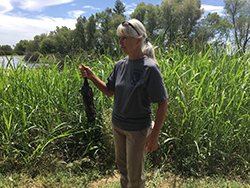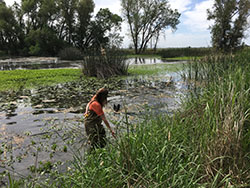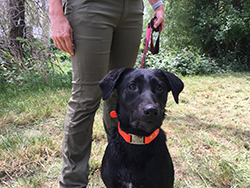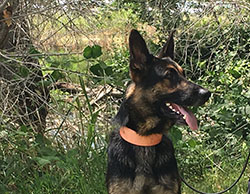
CDFW dog trainer Lynette Shimek uses a dead nutria (caught in the Central Valley) to train Star and Trigger to search and locate the body as well as residual odor from the carcass

Successful nutria detection dogs have to spend a lot of time in the water searching for nutria scent and scat. One of the unknowns when dog training began in May was whether Trigger, a German shepherd, would take to water work. He quickly allayed any concerns.

K9 Star

K9 Trigger
Meet the newest members of CDFW’s “Team Nutria;” a 1-year-old female black Labrador retriever named Star and a 2-year-old male German shepherd named Trigger.
The two scent-detection dogs, their handlers and CDFW’s top canine trainer officially joined CDFW’s nutria eradication effort in late May. The two dogs have been undergoing training to detect nutria scent, scat and residual odor. Recently certified as being proficient at their work, the dogs will soon be deployed to the marshes, wetlands and riparian habit in California’s Central Valley where CDFW teams already have captured some 200 invasive nutria since eradication efforts began this spring.
Star and Trigger are learning quickly and drawing praise.
“Both of these dogs are exceptional to begin with and they are exceeding expectations with how quickly they are adapting to the environment they will be working in,” said Lynette Shimek, CDFW’s canine trainer.
Nutria are semi-aquatic rodents native to South America that have turned up in the Central Valley’s marshes and wetlands and on the edge of the Sacramento-San Joaquin Delta. Their destructive feeding and burrowing threaten the critical wetland habitat needed by native species and jeopardizes the state’s water infrastructure. A top-rated agricultural pest, nutria also pose a serious risk to the state’s multi-billion dollar agricultural economy. CDFW is leading the state’s effort to eliminate nutria from the California landscape.
Nutria, furtive and primarily nocturnal, can be difficult to detect in the heavily vegetative wetland environments they prefer, particularly as trapping knocks down their numbers. Dogs can move more quickly through the wetland habitat and cover more territory than their human partners. The dogs’ responses to nutria scent – sometimes sitting, other times lying down or standing still – can alert CDFW biologists to nutria presence or let them know they need to look elsewhere.
It’s a page right out of the playbook of the federal government’s Chesapeake Bay Nutria Eradication Project, the only successful nutria eradication effort in the United States and a model and source of inspiration for California wildlife officials. That effort removed some 14,000 nutria from more than a quarter-million acres of the Delmarva Peninsula from 2002 to 2015. Nutria detection dogs joined the campaign in 2014 and proved invaluable in finding the last remaining animals. Three years after the last nutria was removed, the project still maintains a team of six nutria detection dogs and their handlers. Their primary role now is not to find nutria necessarily – but rather give biologists confidence that nutria are no longer present.
Many of the Chesapeake Bay nutria detection dogs have been Labrador mixes adopted out of animal shelters. The Labrador blood helps with the water work. The dogs’ high energy and prey drive that made them difficult household pets and forced their owners to surrender them made them ideal working dogs when given a job to do and a focus for their energy.
Star and Trigger, by contrast, have pedigreed bloodlines from proven scent-detection lineage. Still, questions surfaced at the outset of training whether the dogs would take to nutria detection work. Would Trigger, a heavy coated German shepherd, take to water work? Would Star, a bundle of Labrador puppy enthusiasm, have the attention span to stay focused on the job? Their training not only involves accurately identifying nutria scent, but also distinguishing it from that of beaver, muskrat, mink, raccoon and other birds and animals that inhabit the same wetland habitat.
It’s all positive reinforcement. Successful detection is rewarded with praise, affection and play. Star gets to make a few water retrieves of a favorite rubber ball toy. Trigger gets some toy time and a quick game of tug of war.
“They’re both doing extremely well,” said Shimek during a training break recently at the Upper Butte Basin Wildlife Area in Northern California. ”I am extremely confident these two dogs will be a big help in our eradication efforts.”
Star and Trigger are pioneers of sorts as biological detection canines. While CDFW has used canines in law enforcement work since 1989, Star and Trigger are part of two separate pilot programs to determine whether biological detection canines can support CDFW’s scientific work.
Star and Trigger’s handlers are not wildlife officers, but rather environmental scientists Harvest Vieira and Helayna Pera, respectively. Before their nutria assignment, Star was being trained to detect the nests of Western pond turtles, a Species of Special Concern in California due to declining populations. Trigger is trained to find downed deer that have been darted with tranquilizers. He can even locate errant darts from missed shots.
Both Vieira, based in Redding, and Pera, based in Sacramento, believe the nutria eradication effort is exactly the kind of high-profile project where their scent-detection dogs can shine, perhaps leading to a formalized program and additional biological detection dogs that can support CDFW’s various conservation and scientific efforts across the state.
CDFW Photos by Peter Tira. CDFW Video Courtesy of Sandra Jacks. Top Photo: From left to right: Trigger, his handler Helayna Pera, CDFW dog trainer Lynette Shimek, Star’s handler Harvest Vieira, and Star pause for a photo during a training break at the Upper Butte Basin Wildlife Area.